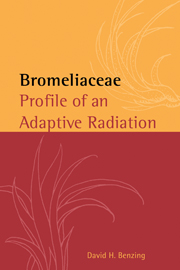Book contents
- Frontmatter
- Contents
- List of contributors
- Preface
- Acknowledgments
- Glossary
- Abbreviations
- Part one Brief overview
- Part two Basic structure, function, ecology and evolution
- 2 Vegetative structure
- 3 Reproductive structure
- 4 Carbon and water balance
- 5 Mineral nutrition
- 6 Reproduction and life history
- 7 Ecology
- 8 Relationships with fauna
- 9 History and evolution
- Part three Special topics
- Literature cited
- Name index
- Subject index
- Taxon index
2 - Vegetative structure
from Part two - Basic structure, function, ecology and evolution
Published online by Cambridge University Press: 19 January 2010
- Frontmatter
- Contents
- List of contributors
- Preface
- Acknowledgments
- Glossary
- Abbreviations
- Part one Brief overview
- Part two Basic structure, function, ecology and evolution
- 2 Vegetative structure
- 3 Reproductive structure
- 4 Carbon and water balance
- 5 Mineral nutrition
- 6 Reproduction and life history
- 7 Ecology
- 8 Relationships with fauna
- 9 History and evolution
- Part three Special topics
- Literature cited
- Name index
- Subject index
- Taxon index
Summary
All of the impressive functional and ecological variety expressed by some 2700 species of Bromeliaceae is grounded on a single body plan, or what Hallé et al. (1978) might consider one architectural model. Widespread occurrence of this same design among extant monocots and the paleoherb hypothesis (Taylor and Hickey 1992) suggest that early Magnoliophyta possessed much the same basic organization. Except for the occasional monocarp, a somewhat larger group of relatively caulescent species (Fig. 2.1), and another modest-sized assemblage of lateral-flowering taxa (Fig. 2.2B), the bromeliads share a distinctly modular bauplan characterized by sympodial branching that leads to series of attached, compact, terminally flowered ramets (Fig. 2.3). Roots, if present beyond the seedling stage, mostly emerge along the lower half of each module.
Vegetative form that favors life on arboreal and lithic substrates also imparts substantial horticultural value to many of the bromeliads. Moreover, some of these same features assure exceptional importance in ecosystems, including indispensability to extensive fauna with diverse needs (Chapter 8). Two plant characteristics warrant special note on all three counts: a generally compact, rosulate shoot (the ramet or module) that often impounds moisture and nutrient-rich solids (creates the phytotelma and consequently the phytotelmata; Fig. 2.4) and the usually peltate foliar trichome (Figs. 2.5–2.9). These attributes, combined with others involving roots and shoots, favor success, including occasional dominance in some of the most exacting kinds of ecospace colonized by vascular flora in tropical America (e.g., Figs. 1.2C, 7.1).
- Type
- Chapter
- Information
- BromeliaceaeProfile of an Adaptive Radiation, pp. 19 - 78Publisher: Cambridge University PressPrint publication year: 2000
- 2
- Cited by



